Airbus A300
The Airbus A300 is a wide-body airliner developed and manufactured by Airbus. In September 1967, aircraft manufacturers in the United Kingdom, France, and West Germany signed a memorandum of understanding to develop a large airliner. West Germany and France reached an agreement on 29 May 1969 after the British withdrew from the project on 10 April 1969. European collaborative aerospace manufacturer Airbus Industrie was formally created on 18 December 1970 to develop and produce it. The prototype first flew on 28 October 1972.
| A300 | |
|---|---|
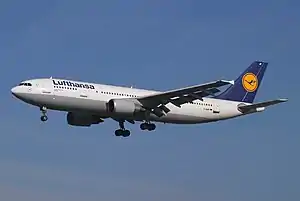 | |
| In Lufthansa livery (2004), the A300 has two underwing podded turbofans, making it the first twinjet wide-body airliner | |
| Role | Wide-body airliner |
| National origin | Multinational |
| Manufacturer | Airbus |
| First flight | 28 October 1972 |
| Introduction | 23 May 1974 with Air France |
| Status | In service |
| Primary users | FedEx Express UPS Airlines European Air Transport Leipzig Mahan Air |
| Produced | 1971–2007 |
| Number built | 561[1] |
| Variants | A300-600ST Beluga Airbus A310 |
| Developed into | Airbus A330 Airbus A340 |
The first twin-engine widebody airliner, the A300 typically seats 247 passengers in two classes over a range of 5,375 to 7,500 km (2,900 to 4,050 nmi). Initial variants are powered by General Electric CF6-50 or Pratt & Whitney JT9D turbofans and have a three-crew flight deck. The improved A300-600 has a two-crew cockpit and updated CF6-80C2 or PW4000 engines; it made its first flight on 8 July 1983 and entered service later that year. The A300 is the basis of the smaller A310 (first flown in 1982) and was adapted in a freighter version. Its cross section was retained for the larger four-engined A340 (1991) and the larger twin-engined A330 (1992). It is also the basis for the oversize Beluga transport (1994).
Launch customer Air France introduced the type on 23 May 1974. After limited demand initially, sales took off as the type was proven in early service, beginning three decades of steady orders. It has a similar capacity to the Boeing 767-300, introduced in 1986, but lacked the 767-300ER range. During the 1990s, the A300 became popular with cargo aircraft operators, as both passenger airliner conversions and as original builds. Production ceased in July 2007 after 561 deliveries. As of June 2022, there were 229 A300 family aircraft in commercial service.
Development
Origins
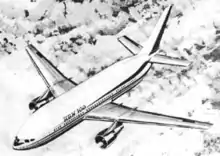
During the 1960s, European aircraft manufacturers such as Hawker Siddeley and the British Aircraft Corporation, based in the UK, and Sud Aviation of France, had ambitions to build a new 200-seat airliner for the growing civil aviation market. While studies were performed and considered, such as a stretched twin-engine variant of the Hawker Siddeley Trident and an expanded development of the British Aircraft Corporation (BAC) One-Eleven, designated the BAC Two-Eleven, it was recognized that if each of the European manufacturers were to launch similar aircraft into the market at the same time, neither would achieve sales volume needed to make them viable.[2] In 1965, a British government study, known as the Plowden Report, had found British aircraft production costs to be between 10% and 20% higher than American counterparts due to shorter production runs, which was in part due to the fractured European market. To overcome this factor, the report recommended the pursuit of multinational collaborative projects between the region's leading aircraft manufacturers.[3]: 49 [4][5]: 2–13
European manufacturers were keen to explore prospective programs; the proposed 260-seat wide-body HBN 100 between Hawker Siddeley, Nord Aviation, and Breguet Aviation being one such example.[2][6]: 37–38 National governments were also keen to support such efforts amid a belief that American manufacturers could dominate the European Economic Community;[7] in particular, Germany had ambitions for a multinational airliner project to invigorate its aircraft industry, which had declined considerably following the Second World War.[3]: 49–50 During the mid-1960s, both Air France and American Airlines had expressed interest in a short-haul twin-engine wide-body aircraft, indicating a market demand for such an aircraft to be produced.[3][8] In July 1967, during a high-profile meeting between French, German, and British ministers, an agreement was made for greater cooperation between European nations in the field of aviation technology, and "for the joint development and production of an airbus".[2][9]: 34 The word airbus at this point was a generic aviation term for a larger commercial aircraft, and was considered acceptable in multiple languages, including French.[9]: 34
_-_53Fi1992_(cropped).jpg.webp)
Shortly after the July 1967 meeting, French engineer Roger Béteille was appointed as the technical director of what would become the A300 program, while Henri Ziegler, chief operating office of Sud Aviation, was appointed as the general manager of the organization and German politician Franz Josef Strauss became the chairman of the supervisory board.[2] Béteille drew up an initial work share plan for the project, under which French firms would produce the aircraft's cockpit, the control systems, and lower-center portion of the fuselage, Hawker Siddeley would manufacture the wings, while German companies would produce the forward, rear and upper part of the center fuselage sections. Addition work included moving elements of the wings being produced in the Netherlands, and Spain producing the horizontal tail plane.[2][6]: 38
An early design goal for the A300 that Béteille had stressed the importance of was the incorporation of a high level of technology, which would serve as a decisive advantage over prospective competitors. As such, the A300 would feature the first use of composite materials of any passenger aircraft, the leading and trailing edges of the tail fin being composed of glass fibre reinforced plastic.[5]: 2–16 [10] Béteille opted for English as the working language for the developing aircraft, as well against using Metric instrumentation and measurements, as most airlines already had US-built aircraft.[10] These decisions were partially influenced by feedback from various airlines, such as Air France and Lufthansa, as an emphasis had been placed on determining the specifics of what kind of aircraft that potential operators were seeking. According to Airbus, this cultural approach to market research had been crucial to the company's long-term success.[10]
Workshare and redefinition
On 26 September 1967, the British, French, and West German governments signed a Memorandum of Understanding to start development of the 300-seat Airbus A300.[6]: 38 [11]: 43 [12]: 57 At this point, the A300 was only the second major joint aircraft programme in Europe, the first being the Anglo-French Concorde.[9] Under the terms of the memorandum, Britain and France were each to receive a 37.5 per cent work share on the project, while Germany received a 25 per cent share. Sud Aviation was recognized as the lead company for A300, with Hawker Siddeley being selected as the British partner company.[2] At the time, the news of the announcement had been clouded by the British Government's support for the Airbus, which coincided with its refusal to back BAC's proposed competitor, the BAC 2–11, despite a preference for the latter expressed by British European Airways (BEA).[9]: 34 Another parameter was the requirement for a new engine to be developed by Rolls-Royce to power the proposed airliner; a derivative of the in-development Rolls-Royce RB211, the triple-spool RB207, capable of producing of 47,500 lbf (211 kN).[13] The program cost was US$4.6 billion (in 1993 Dollars).[14]

In December 1968, the French and British partner companies (Sud Aviation and Hawker Siddeley) proposed a revised configuration, the 250-seat Airbus A250. It had been feared that the original 300-seat proposal was too large for the market, thus it had been scaled down to produce the A250.[5]: 2–14 [8][15] The dimensional changes involved in the shrink reduced the length of the fuselage by 5.62 metres (18.4 ft) and the diameter by 0.8 metres (31 in), reducing the overall weight by 25 tonnes (55,000 lb).[10][16]: 16 For increased flexibility, the cabin floor was raised so that standard LD3 freight containers could be accommodated side-by-side, allowing more cargo to be carried. Refinements made by Hawker Siddeley to the wing's design provided for greater lift and overall performance; this gave the aircraft the ability to climb faster and attain a level cruising altitude sooner than any other passenger aircraft.[10] It was later renamed the A300B.[9]: 34 [15]
Perhaps the most significant change of the A300B was that it would not require new engines to be developed, being of a suitable size to be powered by Rolls-Royce's RB211, or alternatively the American Pratt & Whitney JT9D and General Electric CF6 powerplants; this switch was recognized as considerably reducing the project's development costs.[11]: 45 [15][16]: 16–17 To attract potential customers in the US market, it was decided that General Electric CF6-50 engines would power the A300 in place of the British RB207; these engines would be produced in co-operation with French firm Snecma.[8][10] By this time, Rolls-Royce had been concentrating their efforts upon developing their RB211 turbofan engine instead and progress on the RB207's development had been slow for some time, the firm having suffered due to funding limitations, both of which had been factors in the engine switch decision.[5]: 2–13 [15][16]: 17–18
On 10 April 1969, a few months after the decision to drop the RB207 had been announced, the British government announced that they would withdraw from the Airbus venture.[6]: 38–39 [15] In response, West Germany proposed to France that they would be willing to contribute up to 50% of the project's costs if France was prepared to do the same.[15] Additionally, the managing director of Hawker Siddeley, Sir Arnold Alexander Hall, decided that his company would remain in the project as a favoured sub-contractor, developing and manufacturing the wings for the A300, which would later become pivotal in later versions' impressive performance from short domestic to long intercontinental flights.[5]: 2–13 [9]: 34 [16]: 18 Hawker Siddeley spent £35 million of its own funds, along with a further £35 million loan from the West German government, on the machine tooling to design and produce the wings.[6]: 39 [15]
Programme launch
_at_Le_Bourget_Airport.jpg.webp)
On 29 May 1969, during the Paris Air Show, French transport minister Jean Chamant and German economics minister Karl Schiller signed an agreement officially launching the Airbus A300, the world's first twin-engine widebody airliner.[2] The intention of the project was to produce an aircraft that was smaller, lighter, and more economical than its three-engine American rivals, the McDonnell Douglas DC-10 and the Lockheed L-1011 TriStar.[10] In order to meet Air France's demands for an aircraft larger than 250-seat A300B, it was decided to stretch the fuselage to create a new variant, designated as the A300B2, which would be offered alongside the original 250-seat A300B, henceforth referred to as the A300B1. On 3 September 1970, Air France signed a letter of intent for six A300s, marking the first order to be won for the new airliner.[6]: 39 [10][16]: 21
In the aftermath of the Paris Air Show agreement, it was decided that, in order to provide effective management of responsibilities, a Groupement d'intérêt économique would be established, allowing the various partners to work together on the project while remaining separate business entities.[2] On 18 December 1970, Airbus Industrie was formally established following an agreement between Aérospatiale (the newly merged Sud Aviation and Nord Aviation) of France and the antecedents to Deutsche Aerospace of Germany, each receiving a 50 per cent stake in the newly formed company.[3]: 50 [6]: 39 [10] In 1971, the consortium was joined by a third full partner, the Spanish firm CASA, who received a 4.2 per cent stake, the other two members reducing their stakes to 47.9 per cent each.[10][16]: 20 In 1979, Britain joined the Airbus consortium via British Aerospace, which Hawker Siddeley had merged into, which acquired a 20 per cent stake in Airbus Industrie with France and Germany each reducing their stakes to 37.9 per cent.[3]: 53 [5]: 2–14 [6]: 39
Prototype and flight testing
_-_53Fi1979_(cropped).jpg.webp)
Airbus Industrie was initially headquartered in Paris, which is where design, development, flight testing, sales, marketing, and customer support activities were centered; the headquarters was relocated to Toulouse in January 1974.[8][10] The final assembly line for the A300 was located adjacent to Toulouse Blagnac International Airport. The manufacturing process necessitated transporting each aircraft section being produced by the partner companies scattered across Europe to this one location. The combined use of ferries and roads were used for the assembly of the first A300, however this was time-consuming and not viewed as ideal by Felix Kracht, Airbus Industrie's production director.[10] Kracht's solution was to have the various A300 sections brought to Toulouse by a fleet of Boeing 377-derived Aero Spacelines Super Guppy aircraft, by which means none of the manufacturing sites were more than two hours away. Having the sections airlifted in this manner made the A300 the first airliner to use just-in-time manufacturing techniques, and allowed each company to manufacture its sections as fully equipped, ready-to-fly assemblies.[3]: 53 [10]
In September 1969, construction of the first prototype A300 began.[16]: 20 On 28 September 1972, this first prototype was unveiled to the public, it conducted its maiden flight from Toulouse–Blagnac International Airport on 28 October that year.[6]: 39 [9]: 34 [11]: 51–52 This maiden flight, which was performed a month ahead of schedule, lasted for one hour and 25 minutes; the captain was Max Fischl and the first officer was Bernard Ziegler, son of Henri Ziegler.[10] In 1972, unit cost was US$17.5M.[17] On 5 February 1973, the second prototype performed its maiden flight.[6]: 39 The flight test program, which involved a total of four aircraft, was relatively problem-free, accumulating 1,580 flight hours throughout.[16]: 22 In September 1973, as part of promotional efforts for the A300, the new aircraft was taken on a six-week tour around North America and South America, to demonstrate it to airline executives, pilots, and would-be customers.[10] Amongst the consequences of this expedition, it had allegedly brought the A300 to the attention of Frank Borman of Eastern Airlines, one of the "big four" U.S. airlines.[18]
Entry into service
On 15 March 1974, type certificates were granted for the A300 from both German and French authorities, clearing the way for its entry into revenue service.[18] On 23 May 1974, Federal Aviation Administration (FAA) certification was received.[16]: 22 The first production model, the A300B2, entered service in 1974, followed by the A300B4 one year later.[8] Initially, the success of the consortium was poor, in part due to the economic consequences of the 1973 oil crisis,[6]: 40 [8][9]: 34 but by 1979 there were 81 A300 passenger liners in service with 14 airlines, alongside 133 firm orders and 88 options.[18] Ten years after the official launch of the A300, the company had achieved a 26 per cent market share in terms of dollar value, enabling Airbus Industries to proceed with the development of its second aircraft, the Airbus A310.[18]
Design
_%2540Tokyo.jpg.webp)
The Airbus A300 is a wide-body medium-to-long range airliner; it has the distinction of being the first twin-engine wide-body aircraft in the world.[8][9]: 34 [12]: 57, 60 [19] In 1977, the A300 became the first Extended Range Twin Operations (ETOPS)-compliant aircraft, due to its high performance and safety standards.[6]: 40 Another world-first of the A300 is the use of composite materials on a commercial aircraft, which were used on both secondary and later primary airframe structures, decreasing overall weight and improving cost-effectiveness.[19] Other firsts included the pioneering use of center-of-gravity control, achieved by transferring fuel between various locations across the aircraft, and electrically signaled secondary flight controls.[20]
The A300 is powered by a pair of underwing turbofan engines, either General Electric CF6 or Pratt & Whitney JT9D engines; the sole use of underwing engine pods allowed for any suitable turbofan engine to be more readily used.[12]: 57 The lack of a third tail-mounted engine, as per the trijet configuration used by some competing airliners, allowed for the wings to be located further forwards and to reduce the size of the vertical stabilizer and elevator, which had the effect of increasing the aircraft's flight performance and fuel efficiency.[3]: 50 [16]: 21
Airbus partners had employed the latest technology, some of which having been derived from Concorde, on the A300. According to Airbus, new technologies adopted for the airliner were selected principally for increased safety, operational capability, and profitability.[19] Upon entry into service in 1974, the A300 was a very advanced plane, which went on to influence later airliner designs. The technological highlights include advanced wings by de Havilland (later BAE Systems) with supercritical airfoil sections for economical performance and advanced aerodynamically efficient flight control surfaces. The 5.64 m (222 in) diameter circular fuselage section allows an eight-abreast passenger seating and is wide enough for 2 LD3 cargo containers side by side. Structures are made from metal billets, reducing weight. It is the first airliner to be fitted with wind shear protection. Its advanced autopilots are capable of flying the aircraft from climb-out to landing, and it has an electrically controlled braking system.
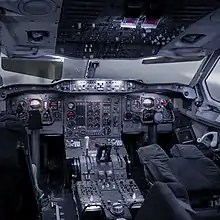
Later A300s incorporated other advanced features such as the Forward-Facing Crew Cockpit, which enabled a two-pilot flight crew to fly the aircraft alone without the need for a flight engineer, the functions of which were automated; this two-man cockpit concept was a world-first for a wide-body aircraft.[8][16]: 23–24 [20] Glass cockpit flight instrumentation, which used cathode ray tube (CRT) monitors to display flight, navigation, and warning information, along with fully digital dual autopilots and digital flight control computers for controlling the spoilers, flaps, and leading-edge slats, were also adopted upon later-built models.[19][21] Additional composites were also made use of, such as carbon-fiber-reinforced polymer (CFRP), as well as their presence in an increasing proportion of the aircraft's components, including the spoilers, rudder, air brakes, and landing gear doors.[22] Another feature of later aircraft were the addition of wingtip fences, which improved aerodynamic performance and thus reduced cruise fuel consumption by about 1.5% for the A300-600.[23]
In addition to passenger duties, the A300 became widely used by air freight operators; according to Airbus, it is the best selling freight aircraft of all time.[20] Various variants of the A300 were built to meet customer demands, often for diverse roles such as aerial refueling tankers, freighter models (new-build and conversions), combi aircraft, military airlifter, and VIP transport. Perhaps the most visually unique of the variants is the A300-600ST Beluga, an oversize cargo-carrying model operated by Airbus to carry aircraft sections between their manufacturing facilities.[20] The A300 was the basis for, and retained a high level of commonality with, the second airliner produced by Airbus, the smaller Airbus A310.[19]
Operational history
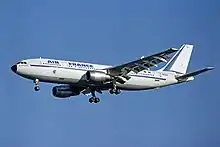
On 23 May 1974, the first A300 to enter service performed the first commercial flight of the type, flying from Paris to London, for Air France.[6]: 39 [18]
Immediately after the launch, sales of the A300 were weak for some years, with most orders going to airlines that had an obligation to favor the domestically made product – notably Air France and Lufthansa, the first two airlines to place orders for the type.[3]: 50–52 [18] Following the appointment of Bernard Lathière as Henri Ziegler's replacement, an aggressive sales approach was adopted. Indian Airlines was the world's first domestic airline to purchase the A300, ordering three aircraft with three options. However, between December 1975 and May 1977, there were no sales for the type. During this period a number of "whitetail" A300s – completed but unsold aircraft – were completed and stored at Toulouse, and production fell to half an aircraft per month amid calls to pause production completely.[18]
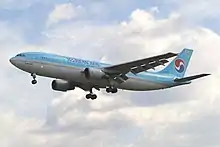
During the flight testing of the A300B2, Airbus held a series of talks with Korean Air on the topic of developing a longer-range version of the A300, which would become the A300B4. In September 1974, Korean Air placed an order for 4 A300B4s with options for 2 further aircraft; this sale was viewed as significant as it was the first non-European international airline to order Airbus aircraft. Airbus had viewed South-East Asia as a vital market that was ready to be opened up and believed Korean Air to be the 'key'.[8][16]: 23 [18]
Airlines operating the A300 on short haul routes were forced to reduce frequencies to try and fill the aircraft. As a result, they lost passengers to airlines operating more frequent narrow body flights. Eventually, Airbus had to build its own narrowbody aircraft (the A320) to compete with the Boeing 737 and McDonnell Douglas DC-9/MD-80. The savior of the A300 was the advent of ETOPS, a revised FAA rule which allows twin-engine jets to fly long-distance routes that were previously off-limits to them. This enabled Airbus to develop the aircraft as a medium/long range airliner.
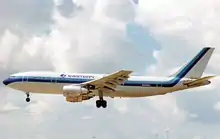
In 1977, US carrier Eastern Air Lines leased four A300s as an in-service trial.[18] Frank Borman, ex-astronaut and the then CEO of the airline, was impressed that the A300 consumed 30% less fuel, even less than expected, than his fleet of L-1011s. Borman proceeded to order 23 A300s, becoming the first U.S. customer for the type. This order is often cited as the point at which Airbus came to be seen as a serious competitor to the large American aircraft-manufacturers Boeing and McDonnell Douglas.[6]: 40 [8][18] Aviation author John Bowen alleged that various concessions, such as loan guarantees from European governments and compensation payments, were a factor in the decision as well.[3]: 52 The Eastern Air Lines breakthrough was shortly followed by an order from Pan Am. From then on, the A300 family sold well, eventually reaching a total of 561 delivered aircraft.[1]
In December 1977, Aerocondor Colombia became the first Airbus operator in Latin America, leasing one Airbus A300B4-2C, named Ciudad de Barranquilla.
During the late 1970s, Airbus adopted a so-called 'Silk Road' strategy, targeting airlines in the Far East.[3]: 52 [18] As a result, The aircraft found particular favor with Asian airlines, being bought by Japan Air System, Korean Air, China Eastern Airlines, Thai Airways International, Singapore Airlines, Malaysia Airlines, Philippine Airlines, Garuda Indonesia, China Airlines, Pakistan International Airlines, Indian Airlines, Trans Australia Airlines and many others. As Asia did not have restrictions similar to the FAA 60-minutes rule for twin-engine airliners which existed at the time, Asian airlines used A300s for routes across the Bay of Bengal and South China Sea.
In 1977, the A300B4 became the first ETOPS compliant aircraft,[24] qualifying for Extended Twin Engine Operations over water, providing operators with more versatility in routing. In 1982 Garuda Indonesia became the first airline to fly the A300B4-200FF. By 1981, Airbus was growing rapidly, with over 400 aircraft sold to over forty airlines.[25]
In 1989, Chinese operator China Eastern Airlines received its first A300; by 2006, the airline operated around 18 A300s, making it the largest operator of both the A300 and the A310 at that time. On 31 May 2014, China Eastern officially retired the last A300-600 in its fleet, having begun drawing down the type in 2010.[26]
From 1997 to 2014, a single A300, designated A300 Zero-G, was operated by the European Space Agency (ESA), centre national d'études spatiales (CNES) and the German Aerospace Center (DLR) as a reduced-gravity aircraft for conducting research into microgravity; the A300 is the largest aircraft to ever have been used in this capacity. A typical flight would last for two and a half hours, enabling up to 30 parabolas to be performed per flight.[27][28]

By the 1990s, the A300 was being heavily promoted as a cargo freighter.[16]: 24 The largest freight operator of the A300 is FedEx Express, which has 65 A300 aircraft in service as of May 2022.[29] UPS Airlines also operates 52 freighter versions of the A300.[30]
The final version was the A300-600R and is rated for 180-minute ETOPS. The A300 has enjoyed renewed interest in the secondhand market for conversion to freighters; large numbers were being converted during the late 1990s.[16]: 24–25 The freighter versions – either new-build A300-600s or converted ex-passenger A300-600s, A300B2s and B4s – account for most of the world freighter fleet after the Boeing 747 freighter.[31]
The A300 provided Airbus the experience of manufacturing and selling airliners competitively. The basic fuselage of the A300 was later stretched (A330 and A340), shortened (A310), or modified into derivatives (A300-600ST Beluga Super Transporter). In 2006, unit cost of an -600F was $105 million.[14] In March 2006, Airbus announced the impending closure of the A300/A310 final assembly line,[32] making them the first Airbus aircraft to be discontinued. The final production A300, an A300F freighter, performed its initial flight on 18 April 2007,[33] and was delivered to FedEx Express on 12 July 2007.[34] Airbus has announced a support package to keep A300s flying commercially. Airbus offers the A330-200F freighter as a replacement for the A300 cargo variants.[35]
The life of UPS's fleet of 52 A300s, delivered from 2000 to 2006, will be extended to 2035 by a flight deck upgrade based around Honeywell Primus Epic avionics; new displays and flight management system (FMS), improved weather radar, a central maintenance system, and a new version of the current enhanced ground proximity warning system. With a light usage of only two to three cycles per day, it will not reach the maximum number of cycles by then. The first modification will be made at Airbus Toulouse in 2019 and certified in 2020.[36] As of July 2017, there are 211 A300s in service with 22 operators, with the largest operator being FedEx Express with 68 A300-600F aircraft.[37]
Variants
A300B1
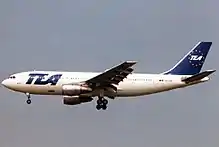
The A300B1 was the first variant to take flight. It had a maximum takeoff weight (MTOW) of 132 t (291,000 lb), was 51 m (167 ft) long and was powered by two General Electric CF6-50A engines.[16]: 21 [38]: 41 Only two prototypes of the variant were built before it was adapted into the A300B2, the first production variant of the airliner.[6]: 39 The second prototype was leased to Trans European Airways in 1974.[38]: 54
A300B2

A300B2-100
Responding to a need for more seats from Air France, Airbus decided that the first production variant should be larger than the original prototype A300B1. The CF6-50A powered A300B2-100 was 2.6 m (8.5 ft) longer than the A300B1 and had an increased MTOW of 137 t (302,000 lb), allowing for 30 additional seats and bringing the typical passenger count up to 281, with capacity for 20 LD3 containers.[39]: 10 [40][38]: 17 Two prototypes were built and the variant made its maiden flight on 28 June 1973, became certified on 15 March 1974 and entered service with Air France on 23 May 1974.[38]: 27, 53 [39]: 10
A300B2-200
For the A300B2-200, originally designated as the A300B2K, Krueger flaps were introduced at the leading-edge root, the slat angles were reduced from 20 degrees to 16 degrees, and other lift related changes were made in order to introduce a high-lift system. This was done to improve performance when operating at high-altitude airports, where the air is less dense and lift generation is reduced.[41]: 52, 53 [42] The variant had an increased MTOW of 142 t (313,000 lb) and was powered by CF6-50C engines, was certified on 23 June 1976, and entered service with South African Airways in November 1976.[38]: 40 [39]: 12 CF6-50C1 and CF6-50C2 models were also later fitted depending on customer requirements, these became certified on 22 February 1978 and 21 February 1980 respectively.[38]: 41 [39]: 12
A300B2-320
The A300B2-320 introduced the Pratt & Whitney JT9D powerplant and was powered by JT9D-59A engines. It retained the 142 t (313,000 lb) MTOW of the B2-200, was certified on 4 January 1980, and entered service with Scandinavian Airlines on 18 February 1980, with only four being produced.[38]: 99, 112 [39]: 14
| Variant | Produced[A] |
|---|---|
| B2-100 | 32 |
| B2-200 | 25 |
| B2-320 | 4 |
| Source:[38]: 110 | |
| A Production figures are listed up to 1 January 1999.[38]: 110 |
A300B4
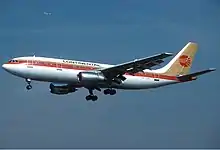
A300B4-100
The initial A300B4 variant, later named the A300B4-100, included a centre fuel tank for an increased fuel capacity of 47.5 tonnes (105,000 lb), and had an increased MTOW of 157.5 tonnes (347,000 lb).[43][41]: 38 It also featured Krueger flaps and had a similar high-lift system to what was later fitted to the A300B2-200.[41]: 74 The variant made its maiden flight on 26 December 1974, was certified on 26 March 1975, and entered service with Germanair in May 1975.[38]: 32, 54 [39]: 16
A300B4-200
The A300B4-200 had an increased MTOW of 165 tonnes (364,000 lb) and featured an additional optional fuel tank in the rear cargo hold, which would reduce the cargo capacity by two LD3 containers.[39]: 19 [41]: 69 The variant was certified on 26 April 1979.[39]: 19
| Variant | Produced[A] | |
|---|---|---|
| B4-100 | 47 | |
| B4-200 | 136 | |
| Source:[38]: 110 | ||
| A Production figures are listed up to 1 January 1999.[38]: 110 |
A300-600
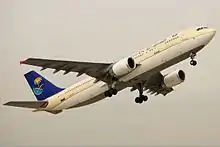

The A300-600, officially designated as the A300B4-600, was slightly longer than the A300B2 and A300B4 variants and had an increased interior space from using a similar rear fuselage to the Airbus A310, this allowed it to have two additional rows of seats.[41]: 79 It was initially powered by Pratt & Whitney JT9D-7R4H1 engines, but was later fitted with General Electric CF6-80C2 engines, with Pratt & Whitney PW4056 or PW4058 engines being introduced in 1986.[41]: 82 Other changes include an improved wing featuring a recambered trailing edge, the incorporation of simpler single-slotted Fowler flaps, the deletion of slat fences, and the removal of the outboard ailerons after they were deemed unnecessary on the A310.[44] The variant made its first flight on 8 July 1983, was certified on 9 March 1984, and entered service in June 1984 with Saudi Arabian Airlines.[39]: 42 [38]: 58 A total of 313 A300-600s (all versions) have been sold. The A300-600 has a similar cockpit to the A310, using digital technology and electronic displays, eliminating the need for a flight engineer. The FAA issues a single type rating which allows operation of both the A310 and A300-600.
- A300-600: (Official designation: A300B4-600) The baseline model of the −600 series.
- A300-620C: (Official designation: A300C4-620) A convertible-freighter version. Four delivered between 1984 and 1985.
- A300-600F: (Official designation: A300F4-600) The freighter version of the baseline −600.
- A300-600R: (Official designation: A300B4-600R) The increased-range −600, achieved by an additional trim fuel tank in the tail. First delivery in 1988 to American Airlines; all A300s built since 1989 (freighters included) are −600Rs. Japan Air System (later merged into Japan Airlines) took delivery of the last new-built passenger A300, an A300-622R, in November 2002.
- A300-600RC: (Official designation: A300C4-600R) The convertible-freighter version of the -600R. Two were delivered in 1999.
- A300-600RF: (Official designation: A300F4-600R) The freighter version of the −600R. All A300s delivered between November 2002 and 12 July 2007 (last ever A300 delivery) were A300-600RFs.
A300B10 (A310)
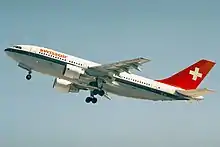
Airbus had demand for an aircraft smaller than the A300. On 7 July 1978, the A310 (initially the A300B10) was launched with orders from Swissair and Lufthansa. On 3 April 1982, the first prototype conducted its maiden flight and it received its type certification on 11 March 1983.
Keeping the same eight-abreast cross-section, the A310 is 6.95 m (22.8 ft) shorter than the initial A300 variants, and has a smaller 219 m2 (2,360 sq ft) wing, down from 260 m2 (2,800 sq ft). The A310 introduced a two-crew glass cockpit, later adopted for the A300-600 with a common type rating. It was powered by the same GE CF6-80 or Pratt & Whitney JT9D then PW4000 turbofans. It can seat 220 passengers in two classes, or 240 in all-economy, and can fly up to 5,150 nmi (9,540 km). It has overwing exits between the two main front and rear door pairs.
In April 1983, the aircraft entered revenue service with Swissair and competed with the Boeing 767-200, introduced six months before. Its longer range and ETOPS regulations allowed it to be operated on transatlantic flights. Until the last delivery in June 1998, 255 aircraft were produced, as it was succeeded by the larger Airbus A330-200. It has cargo aircraft versions, and was derived into the Airbus A310 MRTT military tanker/transport.
A300-600ST
.jpg.webp)
Commonly referred to as the Airbus Beluga or "Airbus Super Transporter," these five airframes are used by Airbus to ferry parts between the company's disparate manufacturing facilities, thus enabling workshare distribution. They replaced the four Aero Spacelines Super Guppys previously used by Airbus.
ICAO code: A3ST
Operators
As of June 2022, there were 229 A300 family aircraft in commercial service. The five largest operators were FedEx Express (70), UPS Airlines (52), European Air Transport Leipzig (22), Mahan Air (13), and Iran Air (11).[45]
Deliveries
| Total | 2007 | 2006 | 2005 | 2004 | 2003 | 2002 | 2001 | 2000 | 1999 | 1998 | 1997 | 1996 | 1995 | 1994 | 1993 | 1992 | 1991 | |
|---|---|---|---|---|---|---|---|---|---|---|---|---|---|---|---|---|---|---|
| Deliveries | 561 | 6 | 9 | 9 | 12 | 8 | 9 | 11 | 8 | 8 | 13 | 6 | 14 | 17 | 23 | 22 | 22 | 25 |
| 1990 | 1989 | 1988 | 1987 | 1986 | 1985 | 1984 | 1983 | 1982 | 1981 | 1980 | 1979 | 1978 | 1977 | 1976 | 1975 | 1974 | |
|---|---|---|---|---|---|---|---|---|---|---|---|---|---|---|---|---|---|
| Deliveries | 19 | 24 | 17 | 11 | 10 | 16 | 19 | 19 | 46 | 38 | 39 | 26 | 15 | 15 | 13 | 8 | 4 |
Data through end of December 2007.[1]
Accidents and incidents
As of June 2021, the A300 has been involved in 77 occurrences including 24 hull-loss accidents causing 1133 fatalities, and 36 criminal occurrences and hijackings causing 302 fatalities.[46]
Accidents with fatalities
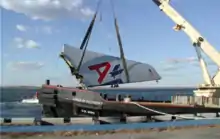

- 21 September 1987: EgyptAir Airbus A300B4-203 touched down 700 m (2,300 ft) past the runway threshold. The right main gear hit runway lights and the aircraft collided with an antenna and fences. No passengers were on board the plane, but 5 crew members were killed.[47]
- 28 September 1992: PIA Flight 268, an A300B4 crashed on approach near Kathmandu, Nepal. All 12 crew and 155 passengers perished.[48]
- 26 April 1994: China Airlines Flight 140 (Taiwan) crashed at the end of runway at Nagoya, Japan, killing all 15 crew and 249 of 256 passengers on board.
- 26 September 1997: Garuda Indonesia Flight 152 was on approach to Polonia International Airport in Medan. The plane later crashed into a ravine in Buah Nabar due to ATC error and apparent haze that covers the country which limits the visibility. All 234 passengers and crew aboard perished in Indonesia's deadliest crash.
- 16 February 1998: China Airlines Flight 676 (Taiwan) crashed into residential area close to CKS international airport near Taipei, Taiwan. All 196 people on board were killed, including Taiwan's central bank president. Seven people on the ground were also killed.
- 12 November 2001: American Airlines Flight 587 crashed into Belle Harbor—a neighborhood in Queens, New York, United States—shortly after takeoff from John F. Kennedy International Airport. The vertical stabilizer ripped off the aircraft after the rudder was mishandled during wake turbulence. All 260 people on board were killed, along with 5 people on the ground. It is the second-deadliest incident involving an A300 to date and the second-deadliest aircraft incident on United States soil.
- 14 April 2010: AeroUnion Flight 302, an A300B4-203F, crashed on a road 2 km (1.2 mi) short of the runway while attempting to land at Monterrey airport in Mexico. Seven people (five crew members and two on the ground) were killed.[49]
- 14 August 2013: UPS Flight 1354, an Airbus A300F4-622R, crashed outside the perimeter fence on approach to Birmingham–Shuttlesworth International Airport in Birmingham, Alabama, United States. Both crew members died.[50]
Hull losses
- 18 December 1983: Malaysian Airline System Flight 684, an Airbus A300B4 leased from Scandinavian Airlines System (SAS), registration OY-KAA, crashed short of the runway at Kuala Lumpur in bad weather while attempting to land on a flight from Singapore. All 247 persons aboard escaped unharmed but the aircraft was destroyed in the resulting fire.[51]
- 24 April 1993: an Air Inter Airbus A300B2-1C was written off after colliding with a light pole while being pushed back at Montpellier.[52]
- In November 1993, an Indian Airlines A300 plane crash landed near Hyderabad airport. There were no deaths but the aircraft was written off.[53]
- 10 August 1994 – Korean Air Flight 2033 (Airbus A300) from Seoul to Jeju, the flight approached faster than usual to avoid potential windshear. Fifty feet above the runway the co-pilot, who was not flying the aircraft, decided that there was insufficient runway left to land and tried to perform a go-around against the captain's wishes.[18] The aircraft touched down 1,773 meters beyond the runway threshold. The aircraft could not be stopped on the remaining 1,227 meters of runway and overran at a speed of 104 knots. After striking the airport wall and a guard post at 30 knots, the aircraft burst into flames and was incinerated. The cabin crew was credited with safely evacuating all passengers although only half of the aircraft's emergency exits were usable}
- 1 March 2004, Pakistan International Airlines Flight 2002 burst 2 tyres whilst taking off from King Abdulaziz International Airport. Fragments of the tyre were ingested by the engines, this caused the engines to catch fire and an aborted takeoff was performed. Due to the fire substantial damage to the engine and the left wing caused the aircraft to be written off. All 261 passengers and 12 crew survived.[54]
- 16 November 2012: an Air Contractors Airbus A300B4-203(F) EI-EAC, operating flight QY6321 on behalf of EAT Leipzig from Leipzig (Germany) to Bratislava (Slovakia), suffered a nose wheel collapse during roll out after landing at Bratislava's M. R. Štefánik Airport. All three crew members survived unharmed, the aircraft was written off. As of December 2017, the aircraft still was parked at a remote area of the airport between runways 13 and 22.[55]
- 12 October 2015: An Airbus A300B4-200F Freighter operated by Egyptian Tristar cargo carrier crashed in Mogadishu, Somalia. All the passengers and crew members survived the crash.[56]
1 October 2016: An Airbus A300-B4 registration PR-STN on a cargo flight between São Paulo-Guarulhos and Recife suffered a runway excursion after landing and the aft gear collapsed upon touchdown, in which the aircraft is still abandoned at airport
Violent incidents
- 27 June 1976: Air France Flight 139, originating in Tel Aviv, Israel and carrying 248 passengers and a crew of 12 took off from Athens, Greece, headed for Paris, France. The flight was hijacked by terrorists, and was eventually flown to Entebbe Airport in Uganda. At the airport, Israeli commandos rescued 102 of the 106 hostages.
- 26 October 1986: Thai Airways Flight 620, an Airbus A300B4-601, originating in Bangkok suffered an explosion mid-flight. The aircraft descended rapidly and was able to land safely at Osaka. The aircraft was later repaired and there were no fatalities. The cause was a hand grenade brought onto the plane by a Japanese gangster of the Yamaguchi-gumi. 62 of the 247 people on board were injured.[57][58][59][60][61][62]
- 3 July 1988: Iran Air Flight 655 was shot down by USS Vincennes in the Persian Gulf after being mistaken for an attacking Iranian F-14 Tomcat, killing all 290 passengers and crew.[63]
- 15 February 1991: two Kuwait Airways A300C4-620s and two Boeing 767s that had been seized during Iraq's occupation of Kuwait were destroyed in coalition bombing of Mosul Airport.[64]
- 24 December 1994: Air France Flight 8969 was hijacked at Houari Boumedienne Airport in Algiers, by four terrorists who belonged to the Armed Islamic Group. The terrorists apparently intended to crash the plane over the Eiffel Tower on Boxing Day. After a failed attempt to leave Marseille following a confrontational firefight between the terrorists and the GIGN French Special Forces, the result was the death of all four terrorists. (Snipers on the terminal front's roof shot dead two of the terrorists. The other two terrorists died as a result of gunshots in the cabin after approximately 20 minutes.) Three hostages including a Vietnamese diplomat were executed in Algiers, 229 hostages survived, many of them wounded by shrapnel. The almost 15-year-old aircraft was written off.
- 24 December 1999: Indian Airlines Flight IC 814 from Kathmandu, Nepal, to New Delhi was hijacked. After refueling and offloading a few passengers, the flight was diverted to Kandahar, Afghanistan. A Nepalese man was murdered while the plane was in flight.[65]
- 22 November 2003: European Air Transport OO-DLL, operating on behalf of DHL Aviation, was hit by an SA-14 'Gremlin' missile after takeoff from Baghdad International Airport. The aeroplane lost hydraulic pressure and thus the controls. After extending the landing gear to create more drag, the crew piloted the plane using differences in engine thrust and landed the plane with minimal further damage. The plane was repaired and offered for sale, but in April 2011 it still remained parked at Baghdad Intl.[66]
- 25 August 2011: an A300B4-620 5A-IAY of Afriqiyah Airways and A300B4-622 5A-DLZ of Libyan Arab Airlines were both destroyed in fighting between pro- and anti-Gadaffi forces at Tripoli International Airport.[67][68]
Aircraft on display
.jpg.webp)
Four A300s are currently preserved:
- F-BUAD Airbus A300 ZERO-G, since August 2015 preserved at Cologne Bonn Airport, Germany.
- ex-HL7219 Korean Air Airbus A300B4 preserved at Korean Air Jeongseok Airfield.
- ex-N11984 Continental Airlines Airbus A300B4 preserved in South Korea as a Night Flight Restaurant.
- ex-PK-JID Sempati Air Airbus A300B4 repainted in first A300B1 prototype colours, including original F-WUAB registration, became an exhibit in 2014 at the Aeroscopia museum in Blagnac, near Toulouse, France.[69]
Specifications

| A300B4-200[70] | A300-600R[71] | A300-600F[72] | |
|---|---|---|---|
| Cockpit crew | Three | Two | |
| Main deck | 281/309Y @ 34/31 in) max 345 |
247 (46F + 201Y)/285Y @ 34 in max 345 (3-3-3 Y) |
540 m³, 43 AYY ULD 9 AMJ/LD7 + 16 AYY |
| Lower deck | 20 LD3 + bulk | 22 LD3 + bulk / 158 m³ | |
| Length | 53.61 m (175.9 ft) | 54.08 m (177.4 ft) | |
| Height | 16.72 m (54.9 ft) | 16.66 m (54.7 ft) | |
| Wing | 44.84 m (147.1 ft) span, 260 m2 (2,800 sq ft) area[73] 7.7 aspect ratio | ||
| Width | 5.287 m (17.35 ft) cabin, 5.64 m (18.5 ft) Fuselage, usually 2-4-2Y | ||
| Pressurized volume | 542 m³ / 19 140 cu ft | 860 m³ / 30 370 cu ft | |
| MTOW | 165,000 kg (363,763 lb) | 171,700 kg (378,534 lb) | 170,500 kg (375,888 lb) |
| Max payload | 37,495 kg (82,662 lb) | 41,374 kg (91,214 lb) | 48,293 kg (106,468 lb) |
| Fuel capacity | 48,470 kg (106,858 lb) | 53,505 kg (117,958 lb) | |
| OEW | 88,505 kg (195,120 lb) | 88,626 kg (195,387 lb) | 81,707 kg (180,133 lb) |
| Engines | CF6-50C2 or JT9D-59A | CF6-80C2 or PW4158 | |
| Takeoff thrust | 230 kN (52,000 lbf)[39] | 249–270 kN (56,000–61,000 lbf)[74] | |
| Takeoff (MTOW, SL, ISA) | 2,300 m (7,500 ft) | 2,400 m (7,900 ft) | |
| Speed | Mach 0.78 (450 kn; 833 km/h) FL350 cruise, MMO Mach 0.82[74] | ||
| Range | 5,375 km / 2,900 nmi | 7,500 km / 4,050 nmi[74] | |
See also
Related development
- Airbus A310
- Airbus A330
- Airbus A340
- Airbus Beluga – modified A300-600
Aircraft of comparable role, configuration, and era
Related lists
- List of jet airliners
References
- "Airbus – Historical Orders and Deliveries". Airbus S.A.S. January 2008. Archived from the original (Microsoft Excel) on 21 December 2008. Retrieved 10 December 2012.
- "Early days (1967–1969)." Archived 5 July 2011 at the Wayback Machine Airbus, Retrieved: 28 February 2016.
- Bowen, John T. The Economic Geography of Air Transportation: Space, Time, and the Freedom of the Sky. "Business & Economics", 2010. ISBN 1-135-15657-3, p. 49-53.
- "Aircraft Industry (Plowden Report)." Hansard, February 1966. vol 723, cc890-1016.
- U.S. International Trade Commission (October 1995). Global Competitiveness of U. S. Advanced-Technology Manufacturing Industries: Large Civil Aircraft. Investigation No. 332-332, Publication 2667. DIANE Publishing. ISBN 978-0-7881-2526-3. pp. 2–16.
- Simons, Graham. The Airbus A380: A History. "Pen and Sword", 2014. ISBN 1-78303-041-0, pp. 37–40.
- Chorafas, Dimitris N. The Business of Europe is Politics: Business Opportunity, Economic Nationalism and the Decaying Atlantic Alliance. Gower Publishing, 2012. ISBN 1-4094-5959-4 p. 292.
- "Airbus at thirty – Family planning." Flight International, 2 January 2001.
- Senguttuvan, P. S. Fundamentals of Air Transport Management. "Excel Books India", 2006. ISBN 81-7446-459-X. pp. 33–34.
- "First order, first flight (1970–1972)." Archived 1 April 2015 at the Wayback Machine Airbus, Retrieved: 28 February 2016.
- Endres, Günter (Spring 2004). "Classic Airliner: Airbus A300". Flightpath: The International Journal of Commercial Aviation. Norwalk, Connecticut, USA: AIRtime Publishing (Volume 3): 43, 45, 51–52. ISBN 1-880588-73-0.
- Pitt, Ivan L. and John Randolph Norsworthy. Economics of the U.S. Commercial Airline Industry: Productivity, Technology and Deregulation. "Springer", 2012. ISBN 1-4615-5031-9, p. 57, 60.
- "Aero Engines 1968: "Flight" special review". FLIGHT International. 93 (3069): 19–30. 4 January 1968.
- "Airbus A300 report". Forecast international. April 2008.
- "Trouble and strife (1968–1969)." Airbus, Retrieved: 28 February 2016.
- Norris, Guy and Mark Wagner (1999). Airbus. Osceola, Wisconsin: MBI Publishing. pp. 16–25. ISBN 0-7603-0677-X.
- "Airliner price index". Flight International. 10 August 1972. p. 183.
- "Champagne ... and drought (1973–1977)." Archived 1 April 2015 at the Wayback Machine Airbus, Retrieved: 28 February 2016.
- "Technology leaders (1977–1979)." Archived 25 September 2015 at the Wayback Machine Airbus, Retrieved: 3 March 2016.
- "A300: the aircraft that launched Airbus." Archived 4 March 2016 at the Wayback Machine Airbus, Retrieved: 3 March 2016.
- Tischler, Mark. B. Advances in Aircraft Flight Control. "CRC Press", 1996. ISBN 0-7484-0479-1, p. 219.
- Park, Soo-Jin. Carbon Fibers. "Springer", 2014. ISBN 94-017-9478-2, p. 257.
- Airbus The European Triumph, Bill Gunston1988, ISBN 0 85045 820 X, p.113
- "Technology leaders (1977–1979)". Aircraft History. Airbus. 17 June 2021.
- Lewis, Paul (31 May 1981). "FOR EUROPE'S AIRBUS INDUSTRIE, IT'S DECISION TIME (Published 1981)". The New York Times. ISSN 0362-4331. Retrieved 8 November 2020.
- Hashim, Firdaus. "PICTURE: China Eastern retires A300-600s." Flight International, 6 June 2014.
- Beysens, Daniel A. and Jack J.W. A. van Loon. Generation and Applications of Extra-Terrestrial Environments on Earth. "River Publishers", 2015. ISBN 87-93237-53-7. p. 63-65.
- "Experience weightlessness on board the 'Zero-G' Airbus." European Space Agency, Retrieved: 3 March 2016.
- "FedEx Express Fleet Details and History". www.planespotters.net. Retrieved 22 May 2022.
- "United Parcel Service (UPS) Fleet Details and History". www.planespotters.net. Retrieved 22 May 2022.
- "Airbus A300 Available For Cargo Charter". Air Charter Guru. 22 December 2016. Retrieved 20 October 2021.
- "A300/A310 Final Assembly to be completed by July 2007". Airbus. 7 March 2006. Archived from the original on 7 October 2008.
- "The last A300 makes its maiden flight". Airbus. 18 April 2007. Archived from the original on 13 May 2007.
- Kaminski-Morrow, David. "PICTURE: Airbus delivers last A300." Flight International, 12 July 2007.
- "Airbus aims to fill freighter void with A330 derivative". Flight International. 14 March 2006.
- Alan Dron (16 May 2017). "UPS to upgrade Airbus A300 cockpits". Air Transport World. Aviation Week Network.
- "WorldCensus2017.pdf". Flightglobal.com. Retrieved 28 June 2018.
- Endres, Günter (1999). Airbus A300. MBI Pub. pp. 17–110. ISBN 9780760308271.
- "Type certificate data sheet A.172 for Airbus A300, A310 and A300-600". EASA. 8 April 2022.
- Simpson, Rod (1999). Airlife's Commercial Aircraft and Airliners. Airlife. p. 28. ISBN 9781840370737.
- Gunston, Bill (2010). Airbus: The Complete Story. Haynes Publishing UK. pp. 38–74. ISBN 9781844255856.
- "Hot and High Operations". SKYbrary Aviation Safety. 25 May 2021. Retrieved 10 April 2022.
- Sweetman, Bill (4 September 1975). "Airbus Industrie spreads its wings". Flight International. Vol. 108, no. 3469. p. 326.
- "Commercial Aircraft of the World". Flight International. Retrieved 29 December 2015.
- "Orders & Deliveries". Airbus. 30 June 2022. Archived from the original on 10 February 2019. Retrieved 9 July 2022.
- "Airbus A300 Statistics". Aviation Safety Network. Retrieved 25 June 2021.
- "Accident description". Aviation Safety Network. 21 September 1987. Retrieved 10 December 2013.
- "The Airbus A300". CBC News. 12 November 2001.
- Harro Ranter (13 April 2010). "ASN Aircraft accident Airbus A300B4-203F XA-TUE Monterrey-General Mariano Escobedo International Airport (MTY)". aviation-safety.net. Retrieved 1 April 2015.
- "Board Meeting: UPS Flight 1354". National Transportation Safety Board. 9 September 2014.
- "Flight MH684 crash", AirDisasters, 18 December 1983, archived from the original on 28 April 2013, retrieved 8 March 2013
{{citation}}: CS1 maint: unfit URL (link) - "Airbus A300B2-1C F-BUAE Montpellier-Frejorgues Airport (MPL)". Aviation Safety Network. Retrieved 25 March 2014.
- "When an A300 landed on a dry lake". 25 June 2020.
- "PIA Flight 2002 accident". Aviation-safety.net. Retrieved 16 March 2010.
- SME – Petit Press, a.s. "V Bratislave havarovalo nákladné lietadlo, zlyhal mu podvozok – Bratislava – bratislava.sme.sk". sme.sk. Retrieved 1 April 2015.
- "Tristar A300 cargo plane crashed in Mogadishu – Aviation Analysis Wing". aviationanalysis.net.
- "Thai Airways International Flight 620".
- Snyder, Janet (29 October 1986). "Police check gangster grenade blast theory". UPI. Retrieved 8 July 2017.
- "Gangster's grenade causes jet scare". The Japan Times. 30 October 1986. Retrieved 8 July 2017.
- "Police say grenade caused Airbus blast". China Daily. 31 October 1986. Retrieved 8 July 2017.
- Haberman, Clyde (4 November 1986). "Thai Plane Incident Prompts a New Look at Japan Gangs". The New York Times. Retrieved 8 July 2017.
- "Yakuza Branches Out". Associated Press. 2 November 1986. Retrieved 8 July 2017.
- "Navy Missile Downs Iranian Jetliner". The Washington Post. 4 July 1988. Retrieved 3 August 2006.
- "Airbus A300C4-620 9K-AHG Mosul Airport (MOS)". Aviation Safety Network. Retrieved 25 March 2014.
- "Why didn't the hijack drama end in Dubai".
- Harro Ranter (22 November 2003). "ASN Aircraft accident Airbus A300B4-203F OO-DLL Baghdad International Airport (SDA)". aviation-safety.net. Retrieved 1 April 2015.
- "5A-IAY Hull-loss description". Aviation Safety Network. Retrieved 27 August 2011.
- "5A-DLZ Criminal occurrence description". Aviation Safety Network. Retrieved 27 August 2011.
- "Musée Aeroscopia". aeroscopia-blagnac.fr. Retrieved 1 April 2015.
- "A300 Airplane Characteristics for Airport Planning" (PDF). Airbus. 1 December 2009. Archived (PDF) from the original on 9 October 2022.
- "A300-600 Airplane Characteristics for Airport Planning" (PDF). Airbus. 1 December 2009. Archived (PDF) from the original on 9 October 2022.
- "A300F4-600 Airplane Characteristics for Airport Planning" (PDF). Airbus. 1 December 2009. Archived (PDF) from the original on 9 October 2022.
- "Airbus Aircraft Data File". Civil Jet Aircraft Design. Elsevier. July 1999.
- "A300-600 / Dimensions & key data". Airbus. 16 June 2021.
Further reading
- Hofton, Andy (10 October 1987). "Commercial Aircraft of the World". Flight International. Vol. 132, no. 4083. pp. 36–79.
- Gunston, Bill (2009). Airbus: The Complete Story. Sparkford, Yeovil, Somerset, UK: Haynes Publishing. ISBN 978-1-84425-585-6.
External links
- Official website
- "This Is The Start of Something Big". Aviation Week. 1968. Archived from the original on 25 February 2022.